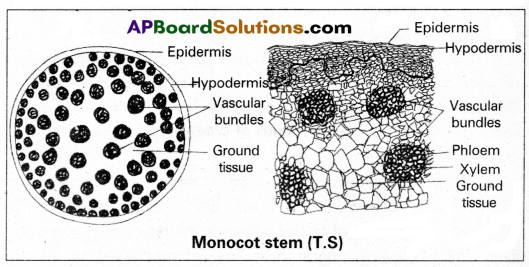Successful navigation through AP Inter 1st Year Botany Model Papers and AP Inter 1st Year Botany Question Paper March 2015 builds students’ confidence in their exam-taking abilities.
AP Inter 1st Year Botany Question Paper March 2015
Time: 3 Hours
Maximum Marks: 60
General Instructions:
Note : Read the following instructions carefully.
- Answer all questions of Section ‘A’. Answer any six questions out of eight in questions Section ‘B’ and answer any two questions out of three in Section – ‘C’.
- In Section ‘A’, questions from Sr. Nos. 1 to 10 are of “Very Short Answer Type”. Each question carries two marks. Every answer may be limited to five lines. Answer all the questions at one place in the same order.
- In Section ‘B’, questions from Sr. Nos. 11 to 18 are of “Short Answer Type”. Each question carries four marks. Every answer may be limited to 20 lines.
- In Section – C, questions from Sr. Nos. 19 to 21 are of “Long Answer Type”. Each question carries eight marks. Every answer may be limited to 60 lines.
- Draw labelled diagrams wherever necessary for questions in Section ‘B’ and C.
Section – A (10 × 2 = 20)
Note : Answer all questions. Each answer may be limited to 5 lines.
Question 1.
Define the terms couplet and lead in taxonomic key.
Answer:
The contrasting characters generally in a pair is called complet. Each statement in the key is called lead.
Question 2.
What is the principle underlying the use of cyanobacteria in agricultural fields for crop improvement ?
Answer:
Cyanobacteria help in nitrogen fixation, thus make the soil fertile and also show oxygenic photosynthesis.
Question 3.
Name the different methods of vegetative reproduction in Bryophytes.
Answer:
In Bryophytes, vegetative reproduction takes place by fragmentation or by gemmae or by bedding in the secondary protonema.
![]()
Question 4.
Define venation. How do dicots differ from monocots with respect to venation ?
Answer:
The arrangement of veins and veinlets in the lamina is called venation. In Dicots Reticulate venation (net like arrangement of veins) is seen. Whereas in monocots, parallel venation (Parallel arrangement of veins) is seen.
Question 5.
What is the morphology of cup like structure in cyathium ? In which family it is found ?
Answer:
In cyathium, cup like structure is formed from Involucre of Bracts. It is seen in Euphorbiaceae family.
Question 6.
What is ‘Omega Taxonomy’ ?
Answer:
Taxonomy based on Information from other branches, i.e., Embryology, cytology, palynology, phytochemistry, serology etc, along with morphological characters is called omega taxonomy.
Question 7.
What is middle Lamella made of ? What is its functional significance?
Answer:
Middle lamella is made up of calcium pectate and magnesium pectate. It holds or glues the neighbouring cells together.
Question 8.
What constituents of DNA are linked by glycosidic bond ?
Answer:
In a polysacharide, the individual monosacharides are linked by a Glycosidic bond. This bond is formed between two carbon atoms of two adjacent monosacharides.
Question 9.
An anther has 1200 pollengrains. How many pollen mother cells must have been there to produce them ?
Answer:
300 pollen mother cells.
Question 10.
Hydrophytes show reduced Xylem. Why ?
Answer:
In hydrophytes, all submerged organs are capable of absorbing water. Thats why xylem is reduced in hydrophytes.
![]()
Section – B (6 × 4 = 24)
Note : Answer any six questions. Each answer may be limited to 20 lines.
Question 11.
Give the salient features and importance of Chrysophytes.
Answer:
- Chrysophytes includes diatoms and desmids.
- They are found in fresh water as well as marine environment.
- They are microscopic and float passively in water currents.
- Most of them are photosynthetic.
- In diatoms, the cell walls form two thin overlapping shells.
- Epitheca over hypotheca which fit together as in a soapbox.
- The walls are embedded with silica and thus the walls are indestructible.
- The cell wall deposits form diatomaceous earth/kieselguhr.
Importance : Diatomaceous earth is used in polishing, Alteration of oils and syrups.
Question 12.
What is meant by homosporous and heterosporous pteridophytes? Give two examples.
Answer:
The condition where only one type of spores are produced is called Homosporous pteridophytes.
Ex : Psilotum, Lycopodium.
The condition where different types of spores are produced is called Heterosporous pteridophytes.
Ex: Selagenella, Salvinia.
Question 13.
List three strategies that a bisexual chasmogamous flower can evolve to prevent self pollination (autogamy).
Answer:
a) Dichogamy : “Pollen release and stigma receptivity are not synchronized”. In sunflower, the pollen the released before the stigma becomes receptive (protandry). In Datura, Solanum, the stigma becomes receptive much before the release of pollen (protogyny) leads to cross pollination.
b) Herkogamy: The male (anther) and female (stigma) sex organs are placed at different positions (Hibiscus) or in different directions (Gloriosa) called Herkogamy. In these plants, the pollen cannot came in contact with the stigma of the same flower, leads to cross pollination.
c) Self-sterility : It is a genetic mechanism which prevents the self pollen from fertilizing the ovules by inhibiting pollen germination or pollen tube growth in the pistil. Ex : Abutilon.
Question 14.
Describe the essential floral parts of plants belonging to Liliaceae.
Answer:
The essential floral parts of Liliaceae are Androecium and Gynoecium.
Androecium : Six stamens in two whorls, free or epiphyllous, anthers are dithecus, basifixed, introrse and dehisce longitudinally.
Gynoecium : Tricarpellary, syncarpous, trilocular, superior ovary with many ovules on axile placentation. Style is terminal and stigma is trifid or capitate.
Question 15.
Describe the structure and function of power houses of cell.
Answer:
Mitochondria is termed as power houses of the cell. It is 0.2 to 1.0 μm in diameter, 1.0 to 4.1 μm in length, appears in cylindrical shape.
Each Mitochondria is a double membrane bound structure with outer smooth membrane and inner membrane with infoldings towards inside called cristae. The space inner to inner membrane is called matrix, which consists of single, circular DNA, few RNA molecules, 70s type of Ribosomes and the components required for the synthesis of proteins. The cristae shows several stalked particles called F1 particles or oxysomes.
Function : Food materials undergo oxidation and releases energy in the form of ATP so called power houses of the cell.
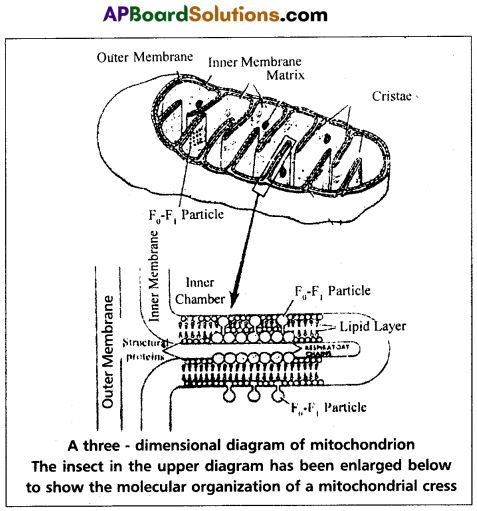
![]()
Question 16.
Though redundantly described as a resting phase, interphase does not really involve rest. Comment.
Answer:
The interphase, also called phase of non apparent division though called the resting phase, is the time during which the cell is preparing for division by undergoing both cell growth and DNA Replication. The
interphase is divided into three further phases. They are
A) G1 phase : It is the interval between mitosis and Initiation of DNA replication. In this cell is metabolically active and continuously grows.
B) ‘S’ phase : In this, DNA replication occurs. The amount of DNA per cell doubles. However three is no increase in the number of chromosomes.
C) G2 phase: Proteins are synthesized in preparation for mitosis while ceil growth continues. So Interphase is not a resting phase.
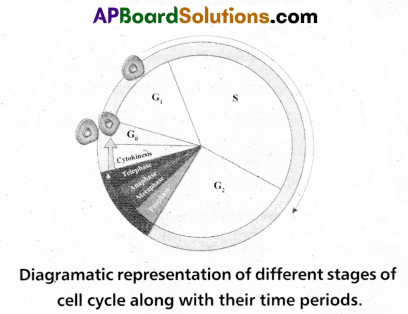
Question 17.
What is the difference between lenticels and stomata ?
Answer:
| lenticels | Stomata |
| 1. Lens shaped openings in the cork of woody stem. | 1. Openings present in the epidermis of the leaf. |
| 2. They contain closely arranged parenchymatous cells. | 2. Stomata is surrounded specialised Guard cells. |
| 3. They permit the exchange of gases between the outer atmosphere and the Inner tissue of the woody organs. | 3. They perform Transpiration and exchange of gases. |
| 4. They are always open. | 4. Opening and closing mechanism ¡s present. |
Question 18.
Give in detail the anatomical adaptations shown by Xerophytes.
Answer:
- Epidermis is covered with thick cuticle to reduce the rate of transpiration.
- Epidermal cells may have silica crystals.
- Epidermis may be multilayered.
- Stomata are generally confined to lower epidermis of leaves and present in pits (Sunken) in some plants.
- Mechanical tissues are relatively well developed.
- Vascular tissues are relatively well developed.
Section – C (2 × 8 = 16)
Note : Answer any two questions. Each answer may be limited to 60 lines.
Question 19.
Define Root modification. Explain how root is modified to perform different functions. Draw neat, labelled diagrams.
Answer:
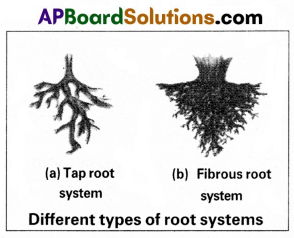
The Radicle of the embryo elongates leads to the formation of primary root which grows into the soil is called root.
In Angiosperms, two types of root systems are present namely,
a) Tap root system
b) Fibrous root system.
a) Tap root system : The primary root grows into the soil, called tap root, which produce lateral roots and root lets constitutes tap root system. It is seen in Dicotyledonous plants.
b) Fibrous root system : The primary root is short lived and is replaced by a large number of roots which orginate from the base of the stem constitutes fibrous root system. It is seen in Monocotyledonous plants.
- Storage Roots : In Carrot, turnip (Tap roots), Sweat potato (Adventitious roots), Asparagus (Fibrous roots) become swollen due to storage of food called storage roots.
- Prop Roots : In Banyan tree, Roots arise from the branches grow into the soil, become pillar like and give additional support called prop roots or pillar roots.
- Stilt Roots : In Maize, sugarcane, roots arise from the lower nodes of the stem, give additional support called stilt roots.
- Respiratory Roots : In Mangroves like Rhizophora and Avicennia, Many roots come out of the ground and grow vertically upwards, help in respiration called Pneumatophores.
- Epiphytic Roots : In Epiphytes like Vanda, special adventitious roots arise, help in absorption of moisture from atmosphere called Velamen roots.
- Parasitic Roots : In partial parasites like viscum and strga, some Haustorial roots enter into xylem of the host plant to get water and Minerals. In complete parasitic like cuscuta and Rafflesia, the haustorial roots enter into xylem and phloem of the host plant and obtain water and Minerals and food materials called Parasitic roots.
- Nodular Roots : In the members of Fabaceae, the roots are inhabited by Rhizobium bacteria which helps in N2 fixation called Nodular roots.
- Photo – synthetic Roots : In some plants like Taeniophyllum, the roots are chloro- phyllous and perform photosynthesis so called photo- synthetic roots.
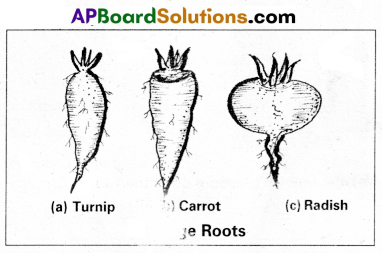
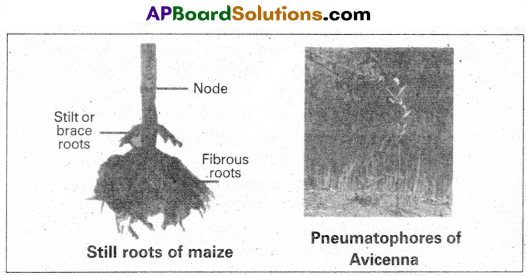

![]()
Question 20.
Describe the process of fertilization in Angiosperms. Draw labelled diagrams.
Answer:
The fusion of male and female gametes is called fertilization. The process of fertilization in angiosperms is described under the following five steps.
A) Entry of the pollen tube into the ovule : The pollen tube enters into the ovule in 3 ways.
- Pologamy : Pollen tube enters into the ovule through micro- phyle. e.g. : Ottelia, Hibiscus.
- Chalazogamy : Pollen tube enters into the ovule through chalaza. e.g. : Casiarina.
- Mesogamy: Pollen tube enters into the ovule through integu-ments or funiculus, e.g. : Cucurbita.
B) Entry of pollen tube into the embryo sac : The pollen tube enters into the embryo sac only through the microphylar region either by destroying one of the synergids or in between egg cell and synergid. The entry of pollen tube is directed by filiform apparatus.
C) Dicharge of male gametes or sperms : After entry of pollen tube into the embryosac, the male gametes are liberated by one of the following ways.
a) Tip of the pollen tube may burst out’
b) Degeneration of the tip of the pollen tube.
c) Formation of an apical pore at the tip of the pollen tube. The pollen tube finally releases the intact male gametes and vegetative nucleus.
D) Gametic Fusion : One of sperm nucleus [first sperm] fuses with egg cell and forms a dipliod zygote (2n). This fusion is called syngamy or fertilization. It was first discovered by Strasburger (1884).
E) Triple fusion and Double fertilization : The second sperm nucleus fuses with the secondary nucleus of the embryosac and forms Primaryendosperm nucleus [PEN], This fusion is called as Triple fusion. It was first observed by Nawaschin in Lilium and Fertillaria. In angiosperms the two male gametes release into the embryo sac take part in two fertilizations. The first sperm nucleus combines with egg cell to form zygote and the second sperm nucleus combines with secondary nucleus to form primary endosperm nucleus. With the occurrence of two fertilizations, this phenomenon is, i.e.. Double (fertilization) includes syngamy as well as triple fusion. It results in the formation of fertile endospermic seeds.
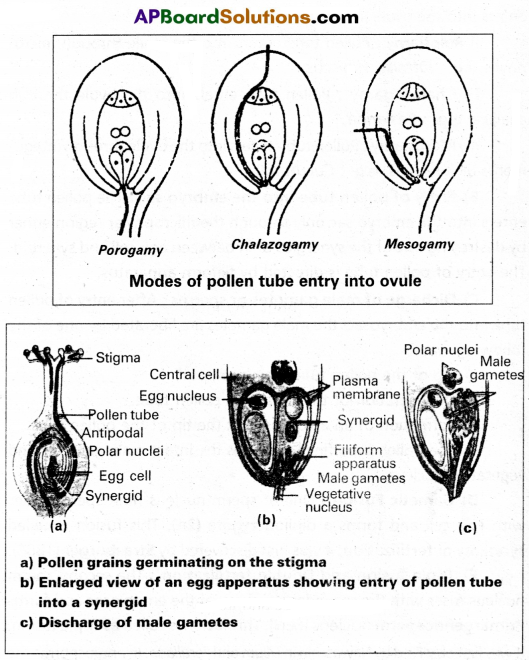
![]()
Question 21.
Describe the T.S. of monocot stem. Give a neat, labelled diagram of T.S. of monocot.
Answer:
The structure of monocot stem can be understood well by observing the T.S of stem of Zea mays. It shows 4 distinct parts., namely
1. Epidermis,
2. Hypodermis,
3. Ground tissue and
4. Vascular bundles.
1) Epidermis: It is the outermost layer composed of rectangular or tubular living cells arranged closely and compactly without intercellular spaces. The cells contain vacuolated protoplasts with a single nucleus but chloroplasts are absent. A waxy layer called ‘cuticle’ is deposited on the external surface of the epidermis. Cuticle prevents the. evaporation of water from the plant body. Trichomes are absent. Numerous stomata are found in the epidermis through which exchange of gases occurs.
Epidermis gives protection to the inner tissues, helps in the exchange of gases and also prevents the evaporation of water.
2) Hypodermis : A distinct cortex is absent in Monocot stems. However a thick walled hypodermis is found beneath the epidermis. The cells of hypodermi; are sclerenchymatous and are arranged compactly in. 3 – 4 rows, without any intercellular spaces. It gives mechanical strength to the stem.
Ground tissue : A major part of the stem is formed by an extensive soft, parencymatous tissue called the ground tissue. The . peripheral layer consists of smaller cells while the inner layers show bigger cells. The cells of peripheral layers are chlorenchymatous and are concerned with assimilation of food materials. The inner layers of cells are concerned with storage of food materials. In monocot stem endodermis is absent.
Vascular bundles : Numerous vascular bundles are found scattered irregularly in the ground tissue. This kind of arrangement is called ‘atactostele’. It is considered an on advanced character. The inner vascular bundles are bigger in size and far-apart from one another. The outer vascular bundles are smaller and are close to one another and found in one or two circles.
Each vascular bundle is oval in shape and shows xylem and phloem together on the same radius. There is no cambium between xylem and phloem. Hence the vascular bundles are called conjoint, collateral and closed. Xylem is at the lower side and phloem at the upper side of the vascular bundle. Each vascular bundle is enclosed by a sheath of sclenrenchymatous fibres. Hence it is called fibro vascular bundle.
Xylem consists of tracheids, vessels, fibres and parenchyma. Xylem vessels are few in number (4) and are arranged in “Y” shape. One or two protoxylem cells are crushed forming lysigeneous cavity called protoxylem lacunae which store water phloem consists of sieve tubes and companion cells. Phloem parenchyma is absent Medulla, Medullary rays and pericycle are also absent.
